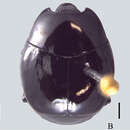Description
provided by Zookeys
Size range: Length: 5–6.5mm, Width: 4–5mm. Body form (Fig. 1B): Oval, convex, piceous, covered with micropunctures. Head (Fig. 3B): Frons flat or with medial longitudinal impression, slightly concave; frontal stria complete or slightly interrupted medially, joined with supraorbital stria laterally at posterior margin; labrum subrectangular with anterior margin nearly straight, posterior margin with a small semicircular smooth area; about two times as wide as long; mandibles short, without subapical teeth. Pronotum (Figs 1B, 3B): Sides rounded, narrower anteriorly; marginal pronotal stria beginning at angles, interrupted behind the head, continuous to posterior margin; lateral pronotal stria present, indicated along lateral and anterior margins; lateral punctures not strongly indicated, but easily visible, equally covering lateral margin. Elytra (Fig. 1B): Marginal epipleural stria absent, elytra with superficial impression in its place; epipleural stria complete; outer subhumeral stria present at posterior half, beginning close to humeral stria, sometimes slightly interrupted medially or anteriorly; inner subhumeral stria absent; first dorsal stria slightly shortened near posterior margin, indicated in posterior third by a series of punctures; second dorsal stria shortened in anterior margin, indicated in posterior fourth by a series of punctures; third dorsal stria weakly indicated, continuous in anterior half, with some punctures near posterior margin; a few punctures close to the posterior margin; sutural stria variable, usually present in posterior half, posterior third or indicated by series of irregularly spaced and variably intense punctures. Prosternum (Fig. 2B): Prosternal lobe rounded, marginal stria complete along anterior margin; lateral punctures of prosternal keel present, weakly indicated; prosternal keel without carinal striae; prosternal process rounded. Mesoventrite (Fig. 2B): Marginal mesoventral stria interrupted, present in lateral margin and slightly along anterior margin; mesometaventral stria present, almost straight, slightly curved towards prosternal process. Metaventrite (Fig. 2B): Lateral metaventral stria continuous with recurrent stria. Abdomen (Fig. 2B): Ventrites smooth medially, with irregular punctures on sides; propygidium almost completely punctate, weaker and more dispersed in middle of anterior half; pygidium punctate regularly distributed. Male genitalia (Figs 6A–G): Eighth sternite divided in two longitudinally elongate sclerites, base with irregular emargination; eighth tergite subrectangular, with pair of anterolateral projections, apex concave; “spiculum gastrale” longitudinally elongate and with anterior margin rounded; ninth tergite divided in two longitudinally elongate sclerites, wider medially, apex without emargination; tenth tergite with two sclerotized areas, longitudinally elongate, almost parallel sided, with small anterior non-sclerotized circular area; aedeagus elongate, cylindrical, basal piece widely and deeply emarginated dorsally; parameres almost completely fused dorsally, except for posterior tenth; fused only in anterior third ventrally, basal margin with a couple of projections dorsally and a concave emargination ventrally; apex truncated, with superficial constriction on each side. Female Genitalia (Figs 8A–E): Eighth sternite with sides rounded, basal margin irregularly sclerotized, apex slightly curved, proximal baculi not fused to sternites; eighth tergite trapezoidal, larger at base, with non-sclerotized medial area, apex with non-sclerotized area medially and laterally; oval area in coxites covered with dense and strong punctures, with setae laterally and ventrally, gonostyle only visible ventrally, articulated with coxites, with three apical setae, two long and one short, valvifer elongate, enlarged at anterior third; spermatheca elongate, smooth in posterior third, annulated on anterior 2/3; spermathecal gland longer than spermatheca, wider in posterior half.
- license
- cc-by-3.0
- copyright
- Daniel P. Moura, Lúcia M. Almeida
- bibliographic citation
- Moura D, Almeida L (2013) Three new species of Omalodes (Omalodes) (Histeridae, Histerinae) from South America ZooKeys 335: 85–99
- author
- Daniel P. Moura
- author
- Lúcia M. Almeida
Distribution
provided by Zookeys
Pará, Rondônia, Amapá, Amazonas (Brazil) and Ichilo (Bolivia). Mostly of the material was collected close to large rivers of those regions, especially in Pará, along the Caruaca river.
- license
- cc-by-3.0
- copyright
- Daniel P. Moura, Lúcia M. Almeida
- bibliographic citation
- Moura D, Almeida L (2013) Three new species of Omalodes (Omalodes) (Histeridae, Histerinae) from South America ZooKeys 335: 85–99
- author
- Daniel P. Moura
- author
- Lúcia M. Almeida

